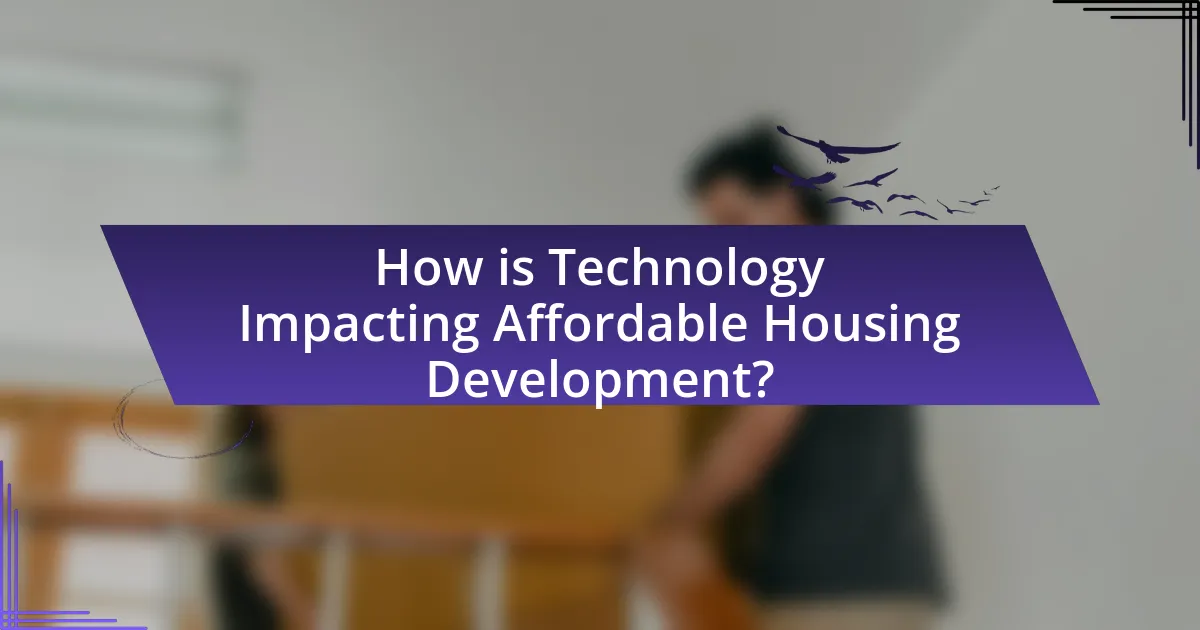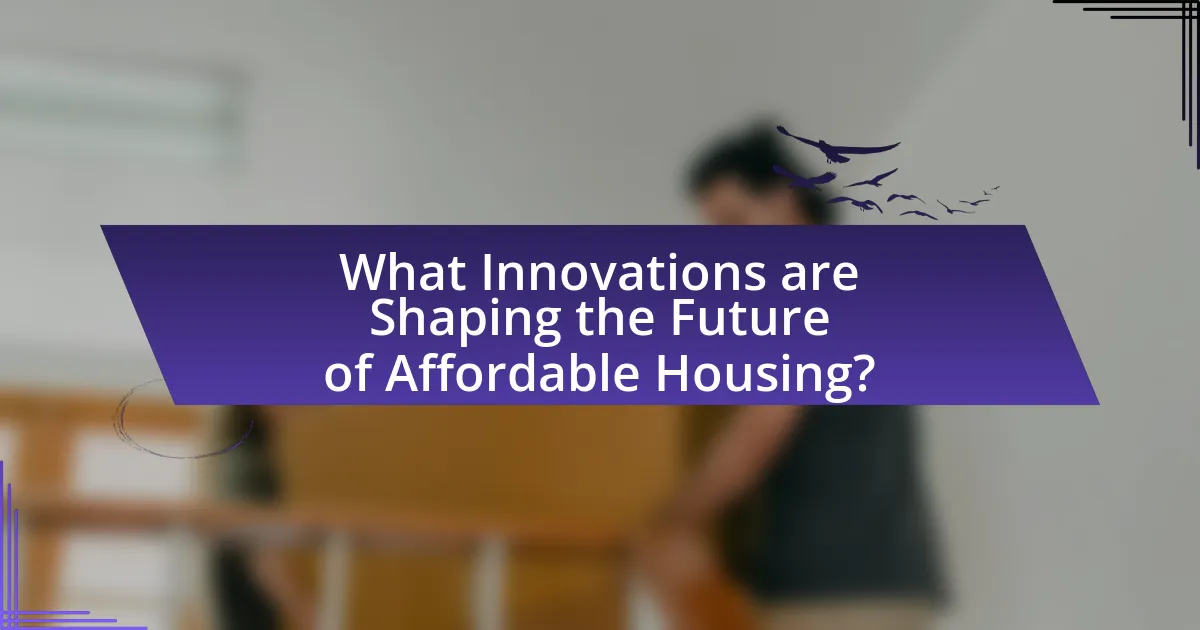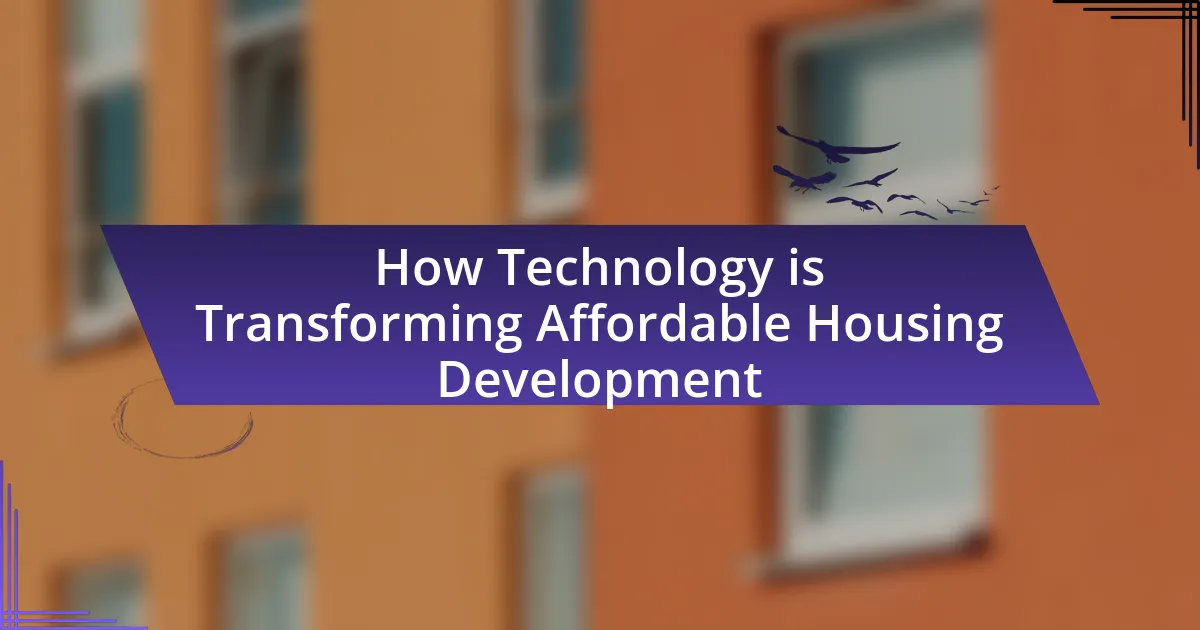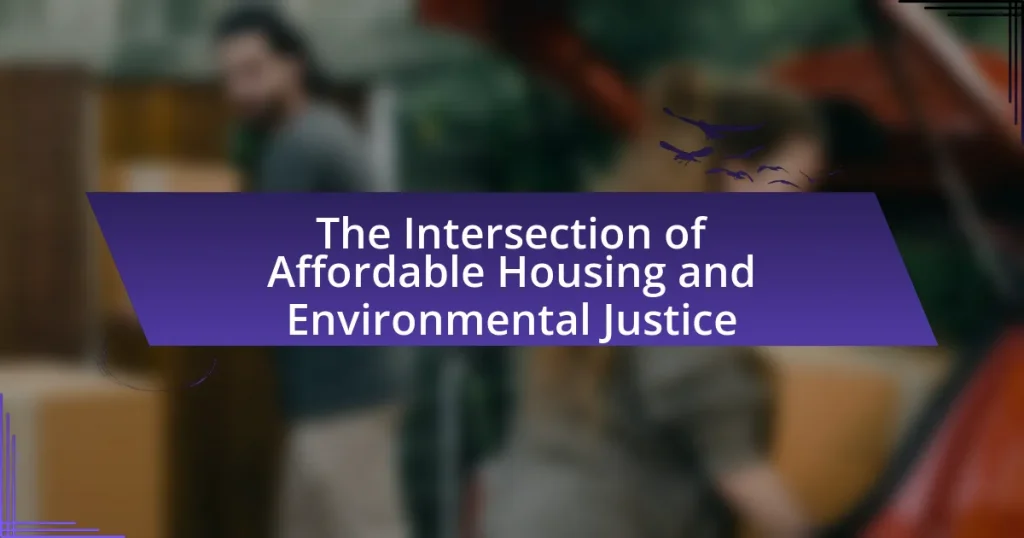The article focuses on how technology is transforming affordable housing development. It highlights key innovations such as modular construction, 3D printing, and smart home technology, which streamline construction processes, reduce costs, and enhance energy efficiency. The use of Building Information Modeling (BIM) and data analytics is discussed as essential for improving project planning and identifying housing needs. Additionally, the article addresses the challenges of implementing technology in this sector, including regulatory barriers and misconceptions, while emphasizing the importance of community engagement and partnerships for successful technology adoption in affordable housing initiatives.

How is Technology Impacting Affordable Housing Development?
Technology is significantly impacting affordable housing development by streamlining construction processes and reducing costs. Innovations such as modular construction, which allows for prefabricated building components to be assembled on-site, can decrease construction time by up to 50% and lower labor costs. Additionally, Building Information Modeling (BIM) enhances project planning and management, leading to fewer errors and waste, which further reduces expenses. Smart technologies, including energy-efficient systems, also contribute to long-term savings for residents, making housing more affordable. According to a report by McKinsey & Company, the construction industry could save $1.6 trillion annually through digital transformation, underscoring the potential of technology to reshape affordable housing.
What are the key technologies driving change in affordable housing?
Key technologies driving change in affordable housing include modular construction, 3D printing, and smart home technology. Modular construction allows for faster building processes and reduced labor costs by prefabricating sections of homes off-site, which can decrease construction time by up to 50%. 3D printing technology enables the creation of homes at a fraction of traditional costs, with some projects reporting construction costs as low as $4,000 per unit. Smart home technology enhances energy efficiency and reduces utility costs, making housing more affordable for residents. These technologies collectively contribute to innovative solutions that address the growing demand for affordable housing.
How do construction technologies enhance efficiency in housing development?
Construction technologies enhance efficiency in housing development by streamlining processes, reducing labor costs, and improving project timelines. For instance, the use of Building Information Modeling (BIM) allows for precise planning and visualization, which minimizes errors and rework. Additionally, prefabrication techniques enable components to be manufactured off-site, leading to faster assembly on-site and a reduction in construction waste. According to a study by McKinsey & Company, the adoption of advanced construction technologies can lead to productivity improvements of up to 50% in certain projects. These technologies not only optimize resource allocation but also facilitate better collaboration among stakeholders, further enhancing overall efficiency in housing development.
What role does data analytics play in identifying housing needs?
Data analytics plays a crucial role in identifying housing needs by enabling stakeholders to analyze demographic trends, economic factors, and housing market dynamics. Through the examination of large datasets, such as census data and housing reports, data analytics helps to pinpoint areas with high demand for affordable housing, assess the characteristics of populations in need, and forecast future housing requirements. For instance, a study by the Urban Institute found that data-driven approaches can improve the targeting of housing assistance programs by revealing specific community needs and preferences, thereby enhancing resource allocation and planning efforts.
Why is technology essential for affordable housing solutions?
Technology is essential for affordable housing solutions because it enhances efficiency, reduces costs, and improves design and construction processes. For instance, the use of Building Information Modeling (BIM) allows for precise planning and resource management, which can decrease construction time by up to 30%. Additionally, modular construction techniques, facilitated by technology, can lower building costs by 20% compared to traditional methods. Furthermore, data analytics can identify housing needs and optimize site selection, ensuring that developments meet community demands effectively. These technological advancements collectively contribute to making affordable housing more accessible and sustainable.
How does technology reduce costs in housing projects?
Technology reduces costs in housing projects by streamlining construction processes and enhancing efficiency. For instance, the use of Building Information Modeling (BIM) allows for precise planning and coordination, minimizing material waste and reducing labor costs. According to a study by McKinsey & Company, implementing digital tools in construction can lead to a 15% reduction in project costs. Additionally, automation and prefabrication techniques can significantly decrease construction time, further lowering expenses associated with labor and project delays.
What are the environmental benefits of using technology in housing development?
The environmental benefits of using technology in housing development include reduced energy consumption, minimized waste, and enhanced resource efficiency. Advanced building technologies, such as energy-efficient systems and smart home automation, significantly lower energy usage by optimizing heating, cooling, and lighting. For instance, the U.S. Department of Energy reports that energy-efficient homes can reduce energy consumption by 30-50%. Additionally, technology facilitates sustainable construction practices, such as modular building and 3D printing, which minimize material waste and reduce the carbon footprint associated with traditional construction methods. Furthermore, the integration of renewable energy sources, like solar panels, in housing developments contributes to decreased reliance on fossil fuels, promoting a cleaner environment.
What challenges does technology face in the affordable housing sector?
Technology faces several challenges in the affordable housing sector, primarily including high implementation costs, lack of standardization, and resistance to change from traditional practices. High implementation costs hinder the adoption of innovative technologies, as many developers may not have the financial resources to invest in advanced solutions. Lack of standardization complicates the integration of new technologies into existing systems, leading to inefficiencies and increased costs. Additionally, resistance to change from stakeholders accustomed to conventional building methods can slow down the adoption of technological advancements. These challenges collectively impede the potential for technology to effectively transform affordable housing development.
How do regulatory barriers impact the adoption of new technologies?
Regulatory barriers significantly hinder the adoption of new technologies by imposing restrictions that slow down innovation and increase costs. For instance, stringent zoning laws and building codes can delay the implementation of advanced construction methods or sustainable materials in affordable housing projects. A study by the National Association of Home Builders found that regulatory costs account for nearly 25% of the final price of a new home, which directly impacts the feasibility of adopting innovative technologies aimed at reducing costs and improving efficiency. These barriers create a challenging environment for developers, ultimately limiting the potential benefits that new technologies can bring to affordable housing development.
What are the common misconceptions about technology in affordable housing?
Common misconceptions about technology in affordable housing include the belief that technology is too expensive for low-income projects, that it complicates rather than simplifies construction processes, and that it cannot effectively address the unique needs of underserved communities. In reality, advancements such as modular construction and 3D printing have significantly reduced costs and construction times, making technology accessible for affordable housing. Additionally, technology can streamline project management and enhance communication among stakeholders, ultimately improving project outcomes. Studies show that integrating technology in affordable housing can lead to better resource management and increased sustainability, countering the notion that it is impractical for such developments.

What Innovations are Shaping the Future of Affordable Housing?
Innovations shaping the future of affordable housing include modular construction, 3D printing, and smart home technology. Modular construction allows for faster building times and reduced labor costs, as components are prefabricated off-site and assembled on location. For instance, a study by the National Institute of Building Sciences found that modular construction can reduce construction time by up to 50%.
3D printing technology is revolutionizing the industry by enabling the creation of entire homes in a fraction of the time and cost compared to traditional methods. Companies like ICON have demonstrated the feasibility of 3D-printed homes, with costs as low as $10,000 for a basic structure.
Smart home technology enhances energy efficiency and reduces utility costs, making housing more affordable in the long run. According to the U.S. Department of Energy, smart home systems can lead to energy savings of 10-30%. These innovations collectively contribute to making affordable housing more accessible and sustainable.
How are smart home technologies influencing affordable housing?
Smart home technologies are influencing affordable housing by enhancing energy efficiency, reducing utility costs, and improving overall living conditions for residents. These technologies, such as smart thermostats and energy-efficient appliances, can lower energy consumption by up to 30%, making housing more affordable for low-income families. Additionally, the integration of smart home systems can lead to better resource management, which is crucial in affordable housing developments where budgets are tight. Studies indicate that properties equipped with smart technologies not only attract more tenants but also maintain higher occupancy rates, thereby increasing the financial viability of affordable housing projects.
What features do smart homes offer to low-income residents?
Smart homes offer low-income residents features such as energy efficiency, enhanced security, and improved accessibility. Energy-efficient appliances and smart thermostats can significantly reduce utility bills, making housing more affordable. Enhanced security systems, including smart locks and surveillance cameras, provide residents with a sense of safety and protection against crime. Additionally, smart home technology can include accessibility features like voice-activated controls and automated lighting, which assist residents with disabilities or mobility challenges. These features collectively contribute to a better quality of life and lower living costs for low-income households.
How can smart technologies improve energy efficiency in affordable housing?
Smart technologies can improve energy efficiency in affordable housing by enabling real-time monitoring and control of energy consumption. These technologies, such as smart thermostats, energy management systems, and IoT devices, allow residents and property managers to optimize heating, cooling, and lighting based on actual usage patterns. For instance, a study by the American Council for an Energy-Efficient Economy found that smart thermostats can reduce energy consumption by up to 10-15% in residential settings. Additionally, integrating renewable energy sources, like solar panels, with smart grid technology can further enhance energy efficiency by allowing for better energy distribution and usage tracking.
What role does modular construction play in affordable housing development?
Modular construction significantly enhances affordable housing development by reducing construction time and costs. This method involves prefabricating building sections in a factory setting, which streamlines the construction process and minimizes on-site labor expenses. According to a study by the National Institute of Building Sciences, modular construction can reduce project timelines by up to 50% compared to traditional methods, leading to faster occupancy and lower financing costs. Additionally, the controlled environment of factories allows for improved quality control and reduced waste, further contributing to cost savings. These efficiencies make modular construction a viable solution for addressing the affordable housing crisis.
How does modular construction compare to traditional building methods?
Modular construction is generally faster and more cost-effective than traditional building methods. This efficiency arises from the off-site fabrication of building modules, which allows for simultaneous site preparation and construction, reducing overall project timelines by up to 50%. Additionally, modular construction often results in less material waste, with estimates indicating a reduction of waste by 20% compared to traditional methods. Furthermore, modular buildings can be assembled in a fraction of the time, with some projects completed in weeks rather than months, enhancing affordability and accessibility in housing development.
What are the cost implications of modular housing solutions?
Modular housing solutions significantly reduce construction costs compared to traditional building methods. The use of prefabricated components allows for faster assembly, which can decrease labor costs by up to 20% and reduce overall project timelines by 30-50%. Additionally, modular construction minimizes material waste, with studies indicating that it can lead to a reduction of waste by 60% compared to conventional methods. This efficiency not only lowers costs but also contributes to sustainability in housing development.
How is 3D printing revolutionizing affordable housing?
3D printing is revolutionizing affordable housing by significantly reducing construction costs and time. This technology allows for the rapid fabrication of building components using materials like concrete, which can lower labor expenses and minimize waste. For instance, companies like ICON have demonstrated that 3D-printed homes can be constructed in as little as 24 hours at a cost of approximately $10,000, making housing more accessible to low-income families. Additionally, 3D printing enables innovative designs that can adapt to various environments, further enhancing the potential for affordable housing solutions.
What are the benefits of using 3D printing in construction?
The benefits of using 3D printing in construction include reduced material waste, faster construction times, and lower labor costs. 3D printing technology allows for precise material usage, minimizing excess and contributing to sustainability; studies indicate that traditional construction methods can generate up to 30% waste, while 3D printing can reduce this significantly. Additionally, 3D printing can accelerate the building process, with some projects completed in a fraction of the time compared to conventional methods, as demonstrated by the ICON 3D-printed homes in Texas, which were built in just 24 hours. Finally, labor costs are decreased due to the automation of the printing process, which requires fewer workers on-site, making it a cost-effective solution for affordable housing development.
How does 3D printing address the housing shortage?
3D printing addresses the housing shortage by enabling the rapid and cost-effective construction of homes. This technology allows for the creation of entire structures using automated processes, significantly reducing labor costs and construction time. For instance, a 3D-printed home can be completed in as little as 24 hours, compared to traditional methods that may take months. Additionally, 3D printing minimizes material waste, as it uses only the necessary amount of materials, which can lead to lower overall costs. According to a report by the World Economic Forum, 3D printing can reduce construction costs by up to 40%, making housing more accessible to low-income families.

What are the Best Practices for Implementing Technology in Affordable Housing?
The best practices for implementing technology in affordable housing include integrating smart building technologies, utilizing data analytics for decision-making, and ensuring community engagement throughout the process. Smart building technologies, such as energy-efficient systems and IoT devices, enhance sustainability and reduce operational costs, which is crucial for affordable housing projects. Data analytics can inform design and operational efficiencies, leading to better resource allocation and improved living conditions. Engaging the community ensures that the technology meets the specific needs of residents, fostering a sense of ownership and satisfaction. These practices are supported by studies indicating that technology adoption in housing can lead to a 20% reduction in energy costs and improved tenant retention rates.
How can developers effectively integrate technology into housing projects?
Developers can effectively integrate technology into housing projects by utilizing smart building systems, sustainable materials, and data analytics. Smart building systems, such as IoT devices, enhance energy efficiency and improve resident comfort by automating heating, lighting, and security. Sustainable materials, like recycled or locally sourced products, reduce environmental impact and lower construction costs. Data analytics enables developers to assess market needs, optimize design, and streamline project management, leading to more efficient use of resources. For instance, a study by McKinsey & Company highlights that implementing advanced technologies can reduce construction costs by up to 20% and improve project timelines by 30%.
What strategies can be used to ensure community engagement in tech adoption?
To ensure community engagement in tech adoption, strategies such as inclusive stakeholder meetings, educational workshops, and feedback mechanisms should be implemented. Inclusive stakeholder meetings allow community members to voice their concerns and ideas, fostering a sense of ownership in the technology being adopted. Educational workshops can demystify the technology, providing residents with the knowledge and skills necessary to utilize it effectively. Feedback mechanisms, such as surveys or focus groups, enable continuous dialogue between developers and the community, ensuring that the technology meets the specific needs of the residents. These strategies have been shown to enhance trust and collaboration, leading to more successful tech adoption in community projects.
How can partnerships enhance technology implementation in affordable housing?
Partnerships can enhance technology implementation in affordable housing by facilitating resource sharing, expertise exchange, and collaborative innovation. For instance, partnerships between government agencies, non-profits, and private tech firms can lead to the development of smart housing solutions that reduce costs and improve living conditions. A study by the Urban Institute found that collaborative efforts in affordable housing projects resulted in a 20% reduction in construction costs and a 30% increase in energy efficiency through the integration of advanced technologies. This demonstrates that partnerships not only leverage diverse strengths but also drive effective technology adoption in affordable housing initiatives.
What lessons can be learned from successful technology-driven housing projects?
Successful technology-driven housing projects demonstrate the importance of integrating innovative construction methods, such as modular building and 3D printing, which significantly reduce construction time and costs. For instance, a study by the Massachusetts Institute of Technology highlighted that 3D-printed homes can be constructed in as little as 24 hours, showcasing a potential reduction in labor costs by up to 50%. Additionally, these projects emphasize the value of data analytics in understanding community needs and optimizing resource allocation, as seen in the Smart Cities initiative in Barcelona, which uses real-time data to enhance urban planning and housing solutions. Furthermore, collaboration between public and private sectors is crucial, as evidenced by the partnership between the City of Los Angeles and private developers, which has led to the successful implementation of affordable housing projects that leverage technology for efficiency and sustainability.
What case studies highlight effective use of technology in affordable housing?
Case studies that highlight effective use of technology in affordable housing include the use of 3D printing in the construction of homes, as demonstrated by ICON’s project in Austin, Texas, where homes were built in just 24 hours at a cost significantly lower than traditional methods. Another example is the use of modular construction techniques by companies like Katerra, which streamline the building process and reduce waste, resulting in faster and more cost-effective housing solutions. Additionally, the use of smart technology in housing developments, such as the Smart Housing Initiative in San Diego, integrates energy-efficient systems and IoT devices to lower utility costs for residents, enhancing affordability. These case studies illustrate how innovative technologies can effectively address the challenges of affordable housing development.
How can these lessons be applied to future developments?
The lessons learned from technology’s impact on affordable housing development can be applied to future developments by integrating innovative construction methods, such as modular building and 3D printing, which have been shown to reduce costs and construction time. For instance, a study by the Massachusetts Institute of Technology highlighted that 3D printing can decrease material waste by up to 60% and cut labor costs significantly. Additionally, leveraging data analytics for site selection and project management can enhance decision-making and resource allocation, as evidenced by successful projects that utilized predictive analytics to optimize timelines and budgets. These applications demonstrate how technology can streamline processes and improve outcomes in future affordable housing initiatives.
What are the key considerations for future technology in affordable housing?
Key considerations for future technology in affordable housing include sustainability, cost-effectiveness, and scalability. Sustainability focuses on using eco-friendly materials and energy-efficient designs to reduce environmental impact, as seen in projects that utilize solar panels and green building certifications. Cost-effectiveness emphasizes the need for technologies that lower construction and maintenance costs, such as modular construction techniques that can reduce labor expenses by up to 20%. Scalability involves the ability to replicate successful housing models in various locations, which is crucial for addressing the growing demand for affordable housing in urban areas. These considerations are essential for leveraging technology to create viable and lasting solutions in affordable housing development.
How can ongoing innovation be sustained in the affordable housing sector?
Ongoing innovation in the affordable housing sector can be sustained through the integration of advanced technologies, collaborative partnerships, and adaptive regulatory frameworks. The use of technologies such as modular construction, 3D printing, and smart building systems can significantly reduce costs and construction time, as evidenced by projects like ICON’s 3D-printed homes, which can be built in a fraction of the time and at lower costs compared to traditional methods. Collaborative partnerships among government entities, private developers, and non-profits can foster resource sharing and innovative financing solutions, as seen in initiatives like the Low-Income Housing Tax Credit program, which incentivizes investment in affordable housing. Additionally, adaptive regulatory frameworks that encourage experimentation with new building methods and materials can facilitate ongoing innovation, as demonstrated by cities that have implemented streamlined permitting processes for innovative housing solutions.
What role does community feedback play in shaping future technologies?
Community feedback plays a crucial role in shaping future technologies by ensuring that innovations align with the actual needs and preferences of users. This feedback loop allows developers and technologists to gather insights directly from the community, which can lead to more effective and user-centered solutions. For instance, in the context of affordable housing development, community input can highlight specific challenges residents face, guiding the design of technologies that address those issues, such as smart home systems that enhance energy efficiency or mobile applications that streamline communication between tenants and management. Research has shown that projects incorporating community feedback are more likely to succeed, as they foster a sense of ownership and trust among users, ultimately leading to higher adoption rates and better outcomes.



